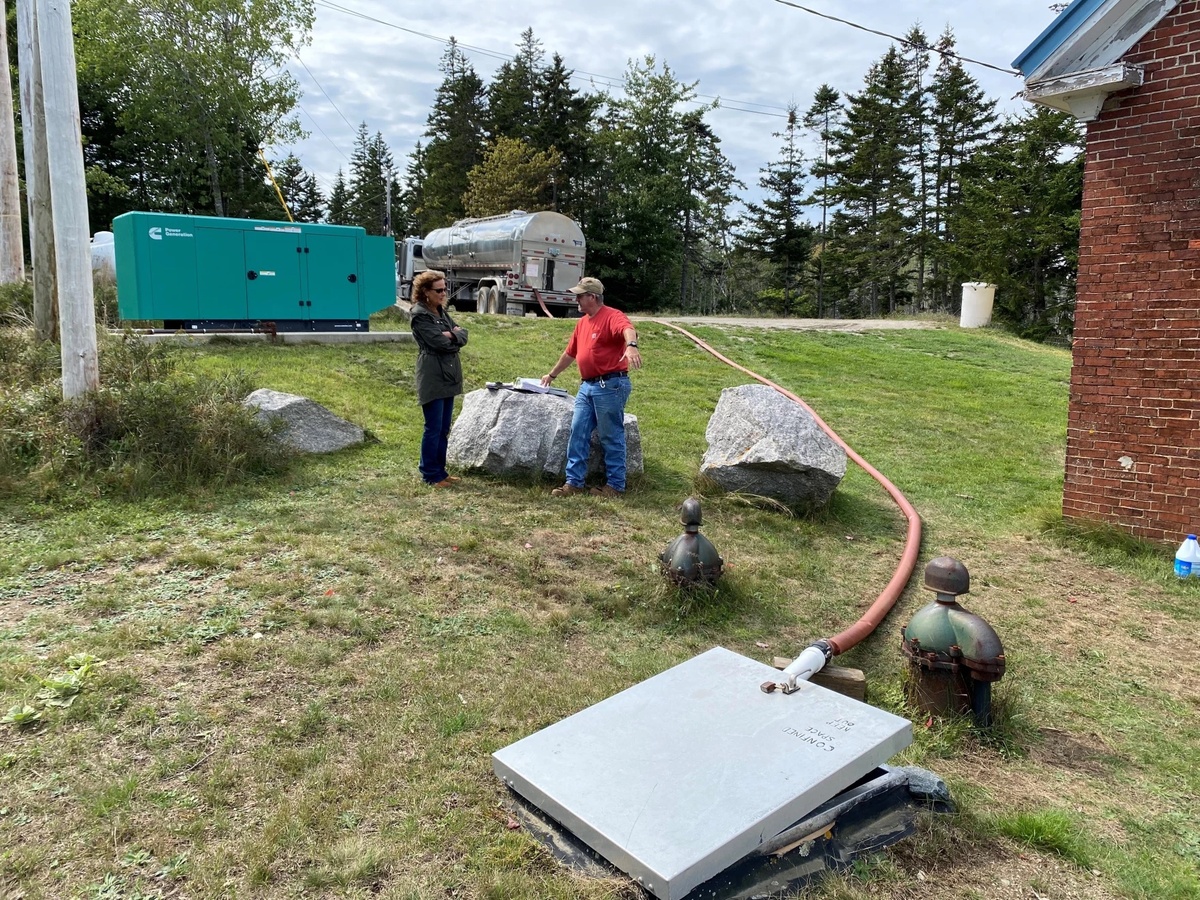Copyright Bangor Daily News

This story appears as part of a collaboration to strengthen investigative journalism in Maine between the BDN and The Maine Monitor. Read more about the partnership. In McGalloway Township, the northernmost reach of Oxford County, homeowner Jessica Champagne is one of many in drought-stricken Maine who is resorting to nearby river water to replenish the family’s well to wash dishes, flush the toilet and shower. “If we need to do laundry, and we have to, we usually go through more water, obviously, for that. So we’ve been really spacing out and being picky on which article of clothing needs to be washed this time,” Champagne said in a telephone interview. Champagne is used to her shallow well’s water dipping low in the summer, but not for such a protracted amount of time as this year. As of Nov. 6, the National Weather Service reported that all of Maine was in a state of drought. And while rain came to parts of the state between Sept. 30 and Oct. 29, it was not much, with some areas seeing between 0.5 and 1.5 inches of rainfall. According to the weather service, “overall conditions are still running significantly below normal, with most of the region running between 30 percent to 60 percent of normal” rainfall. A report released in September by the Maine Drought Task Force attributed the state’s drought conditions “to a 30-day period of time between late July and mid-August when temperatures warmed into the mid to upper 90s over in a half dozen unique events, yet much of the state received less than an inch of rainfall. The evaporation during this period of time was measured at the National Weather Service Office at Caribou over 5”, and estimated to be high in southern Maine.” The downpours that fell late last week across much of the state did little to relieve drought conditions, and, like the Champagne family’s efforts to keep water flowing out of faucets, many families are struggling to find alternative sources of water. “Every day,” Jessica Champagne said, “when my husband gets home from work, he goes across the street with the tractor, the trailer and a tank, and pumps river water into the tank.” Champagne said her family does not release the water directly into the well, but lets it absorb back into the ground. According to the Dry Well Survey, a website set up by the Maine Drought Task Force, which is a coalition of state and federal agencies, utilities and local emergency management offices that coordinate Maine’s response to drought conditions, there were 123 dry wells in Oxford County at the end of October, almost double the number in Cumberland County. The number of dry wells in Washington County is 23. The numbers are generated by homeowners reporting their wells through the Dry Well Survey website, and do not represent every dry well in Maine. Allyson Hill, the director of the Oxford County Emergency Management Association and a member of the task force, said she has been hearing reports of homeowners refilling their wells from local water sources. “I’m unfortunately hearing multiple reports of people doing unsafe and not particularly effective measures to try to solve their problem, which is transferring water out of a river directly into their well, or out of a lake directly into their well, which is not advised and actually isn’t how wells work,” Hill said. She said understanding how wells work can help homeowners who might be dealing with dry wells or are on the cusp of having their own wells run dry. She said water gets into wells from the water table in the ground. It is then filtered through sand and clay and rocks. Dumping water into a well bypasses those natural filters, according to Hill, and can introduce bacteria and water into a home. “You should never pour,” Hill said. In a brief emailed statement, Lindsay Hammes, the press secretary for the Maine Department of Health and Human Services, said adding water to a private well is often illegal. “While there are very few circumstances in which adding water to a private well in Maine is legally allowed, the Maine CDC [Center for Disease Control and Prevention] almost never recommends doing so,” she wrote. Delivering water to a well is unlikely to solve the problem of a dry well and could damage the well and pump, according to Hammes. It can also introduce bacteria into a water system. “Particularly during a drought, water delivered into a dry well is likely to dissipate into the aquifer and may also introduce new bacteria or other pathogens into the aquifer,” she said. “As an example, once iron bacteria is introduced into a well it is difficult (if not impossible) to remove, it clogs the well screen and/or the pump and turns the water reddish-brown.” James Sinko, a meteorologist and hydrologist with the weather service office in Caribou, said Washington County has been hit especially hard by the drought, with 96.4% of the county classified as being in extreme drought. “This is the worst drought Washington County has experienced since 2002,” he said. “We’re seeing rivers running at near record low flow for October, especially the end of October.” Sinko said Washington County has also been dealing with groundwater issues. “We’ve even seen several wells going dry,” he said. “We’ve had a couple of incidents of public water systems running low.” Like several water districts across Maine, the Princeton Water District posted a warning on social media after its well ran dry in late September. That post read: “The Princeton Water District is hoping to have water back to the town sometime this evening. We ask that you use the water conservatively until further notice. Due to the lack of rain and usage our well has been negatively impacted.” Water districts across Maine have urged residents to delay watering lawns and washing automobiles, run only full loads of laundry and dishes and repair leaking faucets to conserve water. Although some rain has fallen unevenly across Maine since September, it has not been enough to address the root of the drought because groundwater takes time to recharge. “When it rains, it takes quite a bit of time for that water to percolate all the way down,” Sinko said. “And when you’re in drought all summer long and then into the fall, we’ve been evaporating and using water more than Mother Nature is supplying water.” There is another complication looming on the horizon: the onset of winter. Once the ground freezes, drought conditions are usually locked in until spring because water cannot dissipate down to wells when the ground is frozen. And Washington County would need much rain to return to normal water table levels before the winter. “At this point, for Washington County especially, 8 to 10 inches of rain would be needed,” Sinko said. “That’s about 125 to 175% of normal rainfall between now and winter to occur to be able to bust this drought. Statistically, that’s not favorable.” Even if the drought is not fully broken, receiving half that amount of rain could help ease some of its most extreme effects. “If we can get half that, we should see … good percolation through the soil, improving rivers, streams, lakes, ponds and the groundwater improving significantly,” Sinko said. In the meantime, Champagne in McGalloway Township said she is dreading the coming of the winter freeze if conditions do not improve. “We’re really scared about going through winter without running water,” she said. If temperatures drop, Champagne will not be able to pump water, and leftover water in the pump could freeze, crack the block and disable an expensive — and essential — piece of equipment. Champagne said her husband spends about a half-hour every night pumping water, and as the days have gotten shorter, that has become an even taller task. “It’s kind of harder to do that because we live right on Route 16, and you don’t want to just be driving around a tractor in the dark,” Jessica Champagne said. Hill said that while the ongoing drought is extreme, it reflects a broader trend of conditions swinging between extremes — either very wet or very dry. “There really doesn’t seem to be a lot of in between,” she said, preparing to adapt during the approaching winter. “This is a homeowner issue, kind of similar to the Ice Storm of ’98, where folks were without power for two weeks and said, ‘We’re not going to do that again.’ Maybe they installed a generator, or a wood stove.” Champagne knows the best way to mitigate the impact of the current drought and future droughts is to drill a deeper well. “I do understand, I really do understand, that it can become amazingly expensive very quickly,” Hill said. “In particular, if you’re doing the hit-or-miss kind of method, you just keep going down feet and feet and feet. But there is science involved. You don’t have to do the hit-or-miss method, where you spend thousands of dollars having somebody drill to not strike water. There are routes you can go that take a more methodical approach to it.” There is another option for mitigation unique to Oxford County: public natural springs where residents can bottle clean drinking water. “We do have three tested springs in Oxford County. They’re the only tested springs in the whole state for potable drinking water,” Hill said. “If you have transportation and you can load up containers, you can fill up with potable water that is clean and take it back to your house.” But for Champagne, the spring nearest to her has been dry for months. And the prospect of redrilling the wells is not realistic. “The suggestion, which I absolutely love: Just have your well redug. Like I just have thousands of dollars laying around that I forgot about,” Champagne said. “And I don’t think people understand what it’s like to live out here like this. Like, your well’s dry. That’s it.”



